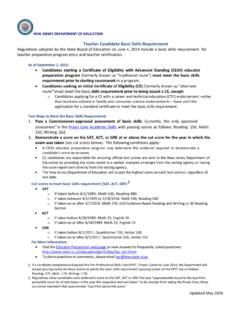Transcription of Strategic Planning Guide - First Nations Health Council
1 Strategic Planning in Smaller Nonprofit Organizations Western Michigan University, April 1999: Reference Source: Bryson, J. M. ( 1995 ). Strategic Planning for public and nonprofit organizations. San Francisco: Jossey-Bass Publishers. This short Guide is designed to help board members and the staff of smaller nonprofit organizations develop Strategic plans that can help them strengthen and sustain their organization's achievements. The workload for nonprofit organizations has increased, and all the while resources have grown scarcer. No longer-as if they ever could-can nonprofit organizations assume their funds will arrive automatically from generous donors, nor can they assume they will have dozens of capable volunteers available to work. Increasingly, funding organizations and even individual donors want to see evidence that their gifts will be put to good use. One piece of evidence they often demand is a Strategic plan.
2 So, what is a Strategic plan, and how can an organization prepare one? This short Guide is designed to help board members and staff of smaller nonprofit organizations develop Strategic plans that can help them strengthen and sustain their organizations' achievements. This Guide contains some suggested steps and methods organizations can use to complete these steps. You will need a comfortable room with tables and chairs and space to move around. It also helps if the room is one that has plenty of wall space that can be used to tape sheets of paper that will come out of the Strategic Planning process. Supplies needed include at least one 27 x 33 inch easel pad, markers for writing on the large sheets of paper, masking tape, 4 x 6 inch pads of Post-it notes (one per person), and felt-tip pens (one per person). What is Strategic Planning ? Most of us know that Planning is a way of looking toward the future and deciding what the organization will do in the future.
3 Strategic Planning is a disciplined effort to produce decisions and actions that Guide and shape what the organization is, what it does, and why it does it (Bryson, 1995 ). Both Strategic Planning and long range Planning cover several years. However, Strategic Planning requires the organization to examine what it is and the environment in which it is working. Strategic Planning also helps the organization to focus its attention on the crucial issues and challenges. It, therefore, helps the organization's leaders decide what to do about those issues and challenges. In short, as a result of a Strategic Planning process, an organization will have a clearer idea of what it is, what it does, and what challenges it faces. If it follows the plan, it will also enjoy enhanced performance and responsiveness to its environment. Who Should be Involved? Each organization must carefully decide who should be involved in Strategic Planning .
4 There are several key roles to be played in a Strategic Planning process including Planning Process Champion. This is usually a key member of the board of directors or the executive director. The person must be someone who believes in Strategic Planning and will help keep the process on track. This person does not have to be an expert in Strategic Planning , but s/he should be someone respected by board and staff members. Plan Writer. Someone must assemble the Planning group's decisions into a cohesive document. This person takes notes during Planning meetings and uses them to prepare a plan, often in the form of several drafts for review by the entire Planning group. Writing the plan, however, is more than simply compiling a record of Planning meetings. The plan writer must also insert options and next logical steps into the drafts at each stage of the Planning process. Planning Process Facilitator.
5 This person may be from outside the organization, though this role also can be played by a member of the board. The facilitator's main responsibility is to plan each meeting's agenda and to ensure the group stays on track. Planning Team. The Planning team's members are those who are most directly involved in laying out the issues and options for the future of the organization. This might be the entire board of directors plus the executive director. It might also be a committee of the board plus the executive director. Key staff beyond the executive director may also be involved. It might also include one (or more). representatives of people served by the organization. What is important to remember is to ensure that the people who are fairly representative of and respected by the organization's leadership are included on the Planning team Board of Directors. The board of directors will ultimately adopt the plan and will use it to Guide its decisions and actions.
6 If the entire board is not involved directly in the Planning process, it must at least approve a Planning process and be kept informed of its progress. The process of developing a Strategic plan is a special opportunity to engage the board of directors in an active role in shaping the organization's future. Staff. Staff members, particularly the executive director, have expertise and information that should be tapped during the Planning process. Since they will be the ones who will carry out the plan on a day-to-day basis, they should be informed and, to whatever extent is appropriate for the organization, involved. Larger organizations often rely on representation from staff, while smaller organizations may include only the executive director on the Planning team. Clients. Those who benefit from the organization's services are sometimes involved in the Planning process. Each organization makes its own choices about whether to include clients on the Planning team or whether to consult them in some other way.
7 Getting Started Each organization needs to decide for itself when the time is right for a Strategic plan. It is sometimes easier to describe when the time is not right than when it is. For example, when the roof has blown off the building, an organization should replace it, not start Strategic Planning . The organization should get its crisis resolved, preferably by acting strategically, and then begin Planning . Something less than a "roof-blown-off" crisis, however, usually prompts organizations to begin Strategic Planning . Some organizations find the loss of a significant funding source or, conversely, the opportunity to obtain a new source of funds, an impetus to plan. Other organizations recognize that their clients are changing and, therefore, they ought to prepare for these changes. And so on. There are as many reasons for starting a Strategic Planning process as there are nonprofit organizations.
8 After deciding to engage in Strategic Planning , the organization should take the following initial steps: List some of the main issues that face the organization. This need not be a complete list, nor does it have to be fully organized. However, knowing some of the concerns of the organization will help those who will be asked to be involved in Planning to prepare. Decide when the plan should be adopted by the board. Developing and drafting a plan will take a few weeks to a few months. The board should set a future board meeting to be the target date for adopting the plan. Set aside some time for the Planning process. Members of the board and staff who will be involved in Planning should agree to take time for the Planning process. This could involve a few hours a week for three to four weeks or it could involve a single day or weekend. The plan writer, of course, will spend more time than others as s/he will be preparing a document that represents decisions made at Planning meetings.
9 I recommend that the total time frame from starting the Planning process to adopting the plan not stretch out for more than three months for a small organization. Decide if a facilitator would be helpful. Some organizations find that an individual who is not directly involved with the organization's regular work can help them with their Planning process. Decide who should be involved and how they should be involved in Planning . See the list on pp. 1-2 for suggestions about the major roles. Find a place for the Planning meetings to occur. It is often helpful to meet someplace other than the standard meeting location for the organization because a different setting can help members of the group step out of their usual patterns. The Planning location should be comfortable, include tables or other surfaces for participants to write, and have room to move around. Having the ability to provide refreshments for Planning participants is also needed.
10 Some organizations use large sheets of paper to record ideas, so having a Planning location that permits hanging paper (using masking tape or other nondestructive adhesive) on the walls is ideal. Steps in the Strategic Planning Process The following outline of steps is a suggestion only. Each organization will need to decide what works and what doesn't. Suggested methods for completing each step and an approximate time frame for each are included as well. Step 1: Mission Review (approximate time required: 30 - 45 minutes). Nearly every organization these days has a mission statement. It is helpful to periodically review the mission and to change it if necessary. An organization's mission is its reason for being, its purpose, or its social justification for existing. Just stating the organization's mission isn't enough. Clarifying the organization's purpose helps eliminate a great deal of unnecessary conflict and helps channel the organization's discussions and activity.








